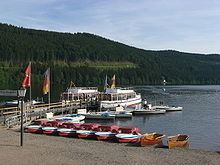Primary inflows Catchment area 24.2 km (9.3 sq mi) Max. length 1.87 km (1.16 mi) Surface elevation 845 m Mean depth 20 m Outflow location Gutach (Kinzig) | Primary outflows Gutach Basin countries Germany Max. width 750 m (2,460 ft) Area 130 ha Cities Titisee-Neustadt | |
 | ||
Similar | ||
The Titisee is a lake in the southern Black Forest in Baden-Württemberg. It covers an area of 1.3 km2 (320 acres) and is an average of 20 m (66 ft) deep. It owes its formation to the Feldberg glacier, the moraines of which were formed in the Pleistocene epoch and nowadays form the shores of the lake. The lake's outflow, at 840 m (2,760 ft) above sea level, is the River Gutach, which merges with the Haslach stream below Kappel to form the Wutach). The waters of the Titisee thus drain eventually into the Upper Rhine between Tiengen and Waldshut. On the north shore lies the spa town of the same name, today a part of the municipality of Titisee-Neustadt.
Contents
- Map of Titisee 79822 Germany
- Origin of the nameEdit
- HistoryEdit
- Winter freezingEdit
- Fauna and floraEdit
- References
Map of Titisee, 79822, Germany
Origin of the nameEdit
There are various theories about the origin of the unusual name Titisee:
HistoryEdit
In 1840, two sarcophagi made of worked tuff were found below a knoll by the outflow of the Gutach from the Titisee. In 2011, the archaeologist, Andreas Haasis-Berner, published an article stating that they had to date to the period between 700 and 900. Hitherto, it had been thought that the High Black Forest had been unsettled during the first millennium.
The first records of the lake date to 1050 and the abbey of Allerheiligen in Schaffhausen, where the name Titinsee is mentioned. The name Dettesee is also mentioned in a deed from the parish of Saig that dates to 1111. The name of the lake adopted its present from around 1750.
Winter freezingEdit
The Titisee takes a long time to freeze over in the winter owing to the winds, which keep the surface of the water moving almost all continuously. For the frozen lake to be opened for use, it must have a solid ice thickness of at least 16 cm (6.3 in) (solid ice or compacted ice has virtually no air pockets). When conditions appear favourable for the opening the lake, daily ice measurements are taken by the Titisee-Neustadt municipal authorities at three or four places. If opening the ice to public use is possible, and those responsible give it their blessing, specific, demarcated areas of the lake are opened, but never the whole lake.
These regulations were put in place after an accident in 1966. Up to that time, the lake had been used in winter as a landing strip for small aircraft. On 14 January 1966, a tractor with a snowplough was clearing the landing strip of snow when it broke through the ice and sank to the bottom of the lake, taking the driver, Walter Wilde (29), with it. His body was only recovered 2 weeks later.
Fauna and floraEdit
In the nutrient-poor Titisee there are large predatory fish (pike-perch, sea trout and a large stock of pike), schooling fish (whitefish, roach and perch) as well as carp, chub and tench in shallower areas. This variety of species is joined by brown trout, char and rainbow trout where the streams enter the lake, and by eels and burbot on the lake bed. In addition there are small fish varieties such as sunbleak, minnow and brook lamprey. Around the lake, grey heron may be seen.
The shores of the Titisee are home to two rare types of quillworts, the spring quillwort and the lake quillwort.
